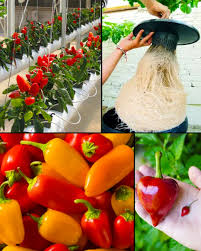Jalapeño peppers are more than just a spicy kick for your dishes—they’re a pleasure to grow, especially when you embrace soilless cultivation techniques. Hydroponics, an innovative alternative to traditional soil gardening, allows you to grow these vibrant peppers efficiently and cleanly. With proper care and a few essential tools, you can produce a thriving jalapeño harvest without ever touching soil.
Understanding Hydroponics
Hydroponics comes from the Greek words “hydro” (water) and “ponos” (labor), meaning “water working.” In this system, plants grow without soil, relying instead on a nutrient-rich water solution to supply essential minerals directly to their roots. This approach results in faster growth, higher yields, and a more controlled growing environment.
Choosing the Right Setup
1. Select Your Hydroponic System:
- Nutrient Film Technique (NFT): A thin stream of nutrient solution flows continuously over the roots.
- Deep Water Culture (DWC): Plants float in a nutrient solution with roots fully submerged.
- Simple Water-Based Setup: Ideal for beginners, these setups require minimal equipment.
2. Nutrient Solution Preparation:
A balanced nutrient solution tailored for jalapeño peppers is essential. You can use commercial hydroponic mixes or create your own. Maintain the solution’s pH between 5.8 and 6.5 for optimal nutrient absorption.
Starting the Growth Process
1. Germinate the Seeds:
- Use the paper towel method: Place seeds on a damp paper towel inside a sealed container until they sprout.
- Alternatively, use a seedling tray with a growing medium like rock wool or peat plugs.
2. Transplant the Seedlings:
Once the seedlings develop strong roots, carefully transfer them to your hydroponic system. Ensure the roots are suspended in the nutrient solution for consistent nourishment.
Maintenance and Care
1. Lighting Requirements:
Jalapeños need six to eight hours of light daily. If natural sunlight is insufficient, use artificial grow lights such as LEDs to replicate optimal light conditions.
2. Monitor Nutrients:
- Regularly check and replenish the nutrient solution.
- Follow the manufacturer’s recommendations to adjust nutrient concentrations as the plants grow.
3. Pruning and Pollination:
- Trim excess foliage to improve air circulation and promote growth.
- Aid pollination by gently shaking the plant or using a soft brush to transfer pollen between flowers.
Troubleshooting

Pests and Diseases:
- Keep the growing area clean to reduce pests like aphids or spider mites.
- Use organic pesticides or neem oil as needed.
Nutrient Deficiencies:
- Watch for signs like yellowing leaves or stunted growth.
- Adjust the nutrient solution to address imbalances promptly.
Harvesting
Jalapeños are ready to harvest when they reach their full size and display their signature bright green or mature red color. Carefully snip the peppers from the plant with scissors or pruning shears to avoid damaging the stems or remaining fruit.
Conclusion
Hydroponic gardening offers a modern and efficient way to grow jalapeño peppers, unlocking the potential for fresh, homegrown produce year-round. With the right setup and attentive care, you can cultivate a bountiful harvest of these flavorful peppers—all while enjoying the benefits of clean, soilless gardening.
